

Newsletter
Issue 61 1983 ~ 2008 February 2008


~~~ NEWSDESK ~~~
Table of contents
Newsdesk, and dates for your diary 2
Museum Update - 4
Merton Abbey Mills update 7
Eric Trim 9
Hydro energy for Ravensbury? 11
Etruria Industrial Museum 12
What is ‘Fulling’? 13
Visits to the Museum have been sporadic over the winter period with more interest shown on sunny days. However we have had three school visits in January — two classes from SS Peter & Paul Primary School on Mitcham Cricket Green and a further visit from Joseph Hood Primary School as part of the Learning Links Project to foster relationships between Schools and Museums.
Outreach - we visited Lonesome Primary School on 6 December for printing sessions with two classes , with Mary’s portable kit once again proving its worth. A successful trip with two classes of 30 crammed in to a single morning so the school could set up the stage for its Christmas play in the afternoon demonstrating how slick the team of Meg, Sheila, Auriel and Mary has become.
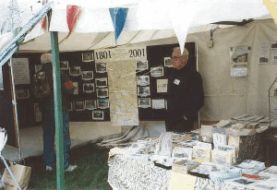 Eric Trim manning our stall at the May Fair in
2001
Eric Trim manning our stall at the May Fair in
2001In February we were pleased to welcome the 16th Morden Scout Group with their Scout Leader Richard Frewin to visit us in preparation for a Wandle Walk that the Group are planning as part of their 60th Anniversary and the 2007 centenary of Scouting.
Volunteers
We were very sorry to hear of the death of Eric Trim in early February. Eric had been a volunteer at the Museum for over ten years before he became ill about three years ago. Despite ill health and the loss of his legs below the knee, he always retained a great interest in all our activities and managed to get to some of our Volunteer Lunches in his wheelchair and also attended some openings of new Exhibitions. He worked in the Museum Shop with both Eric Shaw and the late Derek Huxtable. He will be remembered with great affection for his kindness and cheerfulness.
Events
PAST
The Volunteers quarterly meeting in December had a Christmas theme, with everyone enjoying turkey & stuffing sandwiches, and some of Mary’s well known Christmas cake served up in muffin form. We were able to welcome new volunteer Cy Burman for the first time.
A group of 20 Volunteers and members enjoyed a New Year dinner at Park Place Beefeater in early January. The food and service was excellent and everyone had a great evening.
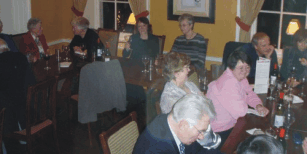 The New Year Dinner
The New Year DinnerPRESENT
The next Volunteers' Quarterly Lunch Meeting is on Wednesday March 19th at 12·00 noon in the Museum and we hope to welcome as many volunteers as possible to this popular event.
Dates for your Diary
Unfortunately we shall not be having our usual stand at the National Trust Fair in Morden Hall Park this year. The Fair organisers Stage-It have increased their costs for hiring a covered row plot to £200 for the three-day event and this is just too expensive to justify our attending. We would be hard pressed to cover our costs let alone make any profit. After twenty years of participating in this event we are very disappointed to be calling it a day.
However, the National Trust are having an Environmental Awareness Day on Sunday May 18th from 12·00-4·00pm and we will be having a free stall at this event, at their kind invitation.
We shall also be having a stall at the Wimbledon Village Fair on Saturday 21st June — all day. So we shall be glad of your help at these two events.
Other dates to remember
Saturday and Sunday 7th/8th June: Wandle Valley Festival
Saturday 14th June: Opening of new Museum Exhibition celebrating 25 years of the Wandle Industrial Museum
Subscriptions
Thank you very much to all of you who have renewed your subscriptions for 2007-8. A renewal form is enclosed for those of you who have not yet done so.
Sheila Harris 13/2/2008
Museum Update
Curators Report
by Meg Thomas
The application for Accreditation has been sent. Leigh Lampard who will be presenting our application has contacted us and listed a few points we need to clarify.
I attended a workshop on copyright. I guess I now know a little more than I did but it is a minefield. I did learn one useful fact, relevant to us. If you take a photograph of a copyrighted artifact you hold the copyright of the photograph as it is considered that a photo has an input of artistic skill.
London Museums Security Group
This group was set up to tackle thefts from museum,archives and libraries. Thefts from museums etc were treated in the same way as domestic robberies where the disposal of the stolen property is usually carried out over a longer period. It often seems that many thefts from museums are 'to order' and that means tracing the stolen goods is much more difficult and has a greater urgency. So this group of specialised officers was created to deal exclusively with museum thefts. To aid this rapid tracing of stolen property a web site was set up, onto which the stolen items could be posted immediately. The theft of large nationally important artifacts attract much publicity but the majority of objects stolen are small, something that can be slipped into a pocket or under a coat. These thefts are usually carried out by people who look upon it as their day job. Going to 'work' each day visiting museums on the look out for vulnerable items seeing how well they are protected and planning when is the best time to steal them. One interesting fact emerges from their records, the peak time for thefts is Thursday and Friday afternoons, perhaps because Portobello Road and similar street markets are open on Saturday. One or two methods used to remove artifacts were described to us, but I won't reveal them, you never know who may be reading our newsletter! The good news is that so far this year there have been no reported thefts from museums, it would seem the group is having an effect.
New Exhibition
As many of you will know the museum was founded in 1983, and this means this year is our 25th anniversary. The new exhibition will look back and look forward. The museum has had a checkered history and often seems to have survived by the skin of its teeth and,of course, the devotion of the volunteers. To help me with the task of recounting the story of the museum any memories you have of the early days would be most welcome and particularly photographs.
Meg Thomas, Feb 2008
Ravensbury
Although nothing concrete to report, what we can say is that Cllr Maurice Groves has been keeping up sustained pressure on our behalf, and it looks like it may, at least, be bearing fruit.
English Heritage have become involved, helping the freeholder to source builders able and willing to carry out the remaining works, and the Merton Planning enforcement office remain on the case.
We have many concerns, not least the way we are excluded from all the meetings and consultations which are ongoing, and the fact that, two years after first having it referred to them, the Merton Legal department has still not got to grips with the HLF documentation.
Wandle Pollution
As many of you will have read in the local press, Thames Water has stumped up £500,000 over 5 years to fund the restoration of the river to its pre disaster state, and there are many encouraging signs of that regrowth already.
Wandle Trust remain the channel through which the money will be distributed, and, after a false start, seem now to be engaging more fully with all the entities with an interest in this subject, not least the riparian local authorities and National Trust whose exclusion from the earlier stages raised serious questions.
There remains national interest in this, and BBC1 included a report on the Wandle in its program last Friday. We have a copy for archive and research purposes - the BBC researchers have included some historic footage and images that we have not seen before.
Wandle Valley Country Park
We remain associated with this endeavour. The Wandle Forum is falling into place as the consultative body, with much of the main work being carried out by Groundwork London (into which Groundwork Merton has merged). A Spatial Vision and Implementation Plan for the Park is due to be issued in June, and much more will be known by then.
The most interesting current development is the beginning of a campaign to divert some of the precept currently being paid by all London Boroughs to the Lea Valley Park to the direction of the Wandle - either by subsidy from Lea Valley, or by a statutory amendment.
Wandle Valley Festival
Planning for the 2008 festival is well advanced, and we hope to have a new, brighter and more current website up before then.
Even more exciting is that the festival has commissioned Dave Saxby to write a new Mills of the Wandle Booklet, to be issued in time for the festival, and to be a companion to the Wildlife booklet from last year as a source of information that walkers along the Wandle Trail can refer to quickly and easily as they go. There has never been a guide like this to the mills of the Wandle, and it is long overdue. More next newsletter.
Michael Hart, running for Charity
And finally, Michael, to whom we all owe so much for his work on our website, is currently training for the London 10k Charity run which will be held on 6 July. He is rasing money for Multiple Sclerosis, and anyone considering sponsoring him can do so by logging in to www.justgiving.com/michaelhart. All contributions gratefully received
Ed., Feb 2008
Merton Abbey Mills Update
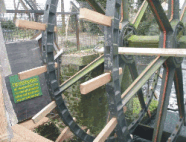
Visitors to the site over the next week or so should be able to see members Steve Llewellyn and Norman Fairey completing the quinquennial renewal of the blades of the waterwheel. This is highly skilled work, carried out in their own time and at minimal cost to Merton Heritage, whose responsibility this is.
The wheel has been stripped back - see image, and they are now awaiting delivery of the new wood from the plant where it has been undergoing chemical treatment to inhibit the inevitable rot.
We should all be grateful for their efforts, and for the learning curve they are undergoing which will be so valuable to us when we move to Ravensbury.
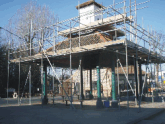
There have been a number of planning applications affecting the site, one of which - that involving the demolition of the bandstand - has been withdrawn. This is a great relief to those of us who regard it as the heart of the site even though a complete anomaly from a heritage point of view. Consequent on this, work is being carried out to renovate it and make it good for another 20 years.
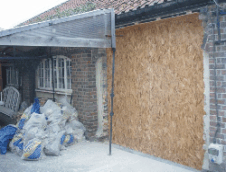
More concerning is the news that the Council’s planning committee passed plans for building works to be carried out to the Long Shop on the apparent basis that there were no heritage objections to the proposals. This appears to be because no heritage group was actually informed of these plans.
What is involved is the demolition of the spacer sections of the exterior long walls, with their arts and crafts curved windows, to be replaced by glazed openings of a modern design.
Had this proposal been required to pass through CADAP first, as we have now recommended several times should be obligatory for all sensitive heritage structures whatever their size, I have no doubt that the commercial reality of what was proposed for the long term viability of the site would have been accepted, but stringent requirements properly imposed to preserve the arts and crafts character of the building. For some reason it was regarded as a purely commercial proposition by the committee, despite the building’s status on the local list.
Ed., Feb 08Tribute to Eric Trim
16 / 6 / 1922 to 2 / 2 / 2008.
Eric was a long standing and valued volunteer at the Museum, and many of us attended his funeral. Maria, his daughter, did not speak at the funeral, but penned the following for the officiating priest to read out. Her words require no editing, or explanation, but speak for themselves.
“Eric Trim, Eric the Red, Earwick, E.A.T. or Dad”
“Tributes are always hard to write as there are many facets to a person and people remember them at different ages and times in their life
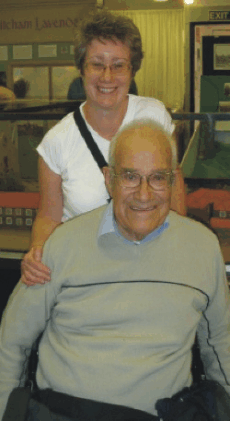 Eric with Maria at the opening of the
Museum’s 2007 exhibition
Eric with Maria at the opening of the
Museum’s 2007 exhibitionWhen talking to family and friends about Eric the same qualities came through
He loved a joke and a chat. Always interested in others, he gave a lot and asked for nothing in return.
The things each of you said ALL of you saw. Therefore no timeline remembrance just short snippets of things he liked. I can hear him say "Keep it simple Maria".
Pub lunch and a pint with friends.
Gardening, pottering in his shed.
His trade as a cabinetmaker, the feel and smell of real wood.
Jokes with workmates
Shove ha'penny, games of cards.
Bicycle and bus rides.
Snap photos, collecting information and exploring new places.
Wednesday afternoons down the local Museum, coach outings and history talks.
Chats over the garden fence, along the road or on the bus.
Archaeology and shipwrecks. Swimming. London's South Bank, Streatham Common, Hampton Court, Brighton, Pall Mall and Howth in Ireland.
Young people.
[pause, while the Bachelors 1963 song ‘I believe’ is played]
There was another side to him, one that had shown itself over the years but never more than the last three. It shone through. Fight, the will and determination to live and enjoy.
At this time he again met and made many new friends that also did not expect to be in this position. Eric's old friends made life better for him.
Hard work, grit and a positive outlook not to be beaten down took him through.
Eric's motto "Get out and enjoy life while you can".
PS: Imagine you are 16, studying for your exams placed opposite in hospital an elderly man who is wheezing all the time.
On the day my dad died he told me this girl had helped him four times that morning. On leaving I went to thank her. With a very determined voice she said: "He is so lovely, it's no trouble, I really like him." On that note I left
Dad that's you and I am very proud of you
love Maria”
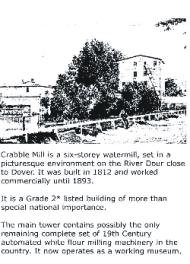
WIM LOOK AT MICRO HYDROPOWER FOR RAVENSBURY MILL
by Ray Leyden
I attended a Micro- Hydro seminar hosted at Crabble Corn Mill, on the River Dour, in Kent on Thursday 24th January 2008 and organized by The British Hydropower Association (BHA) to listen to Hydro basics and gain the Environment Agency perspective along with Case Studies to see how it could be applied to Ravensbury Mill.
Add ... Energy costs, environmental concerns, security of supply etc. So, how do we find out if a hydro scheme will be feasible etc?
One of the case studies by Consultant, Segen Ltd, was the installation of such a scheme at Crabble Corn Mill where the seminar was held. We had a guided tour afterwards although the commissioning was still ongoing.
The installation was a proven success and had now become part of the Tourist attraction.
The other benefit is that with the power generated by the water it can also generate a financial income for the Site.
We would need to revisit this site to see how it has performed over a yearly cycle so that we may measure its success. If the sums add up we have made enough contacts to organize a Feasibility Study for Ravensbury Mill to see if it is viable. With Climate change it certainly would fit into the sustainable future that we all need to become a part of.
Ray Leyden 20/02/2008
Etruria Industrial Museum
When out and about and you come across a local museum, especially if it has industrial in its name, what can you do but visit it?
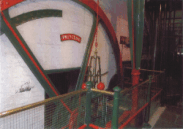 ‘The Princess’
‘The Princess’At the junction of the Trent & Mersey and the Caldon canals we came across the Etruria Industrial Museum, rather an exotic name to find in the middle of the potteries. The area was named by Josiah Wedgwood after the Italian district famous for its pottery. Its central position made Etruria a key area in the 19th century. Etruria Bone and Flint mill was established in 1857 by Jesse Shirley. It ground bones and flint to be used in the pottery industry and in agriculture.
Canals are wonderful for transport but don't flow quickly enough to power a mill wheel so the mill was powered by a steam driven beam engine, 'The Princess', which is made to a James Watt design.
Cattle bones were delivered to the mill still with traces of flesh on them. They were then boiled to remove the meat and grease, after that they were calcined or burnt to remove the moisture and make them brittle. The burnt bones were then mixed with water and ground in pans, this took about eight hours.
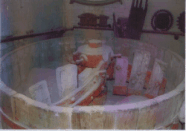 Bone settling tank
Bone settling tankThe resulting 'slop' was run off through gulleys into settling tanks. The bones sank to the bottom and water which rose to the top was drained off.
The final drying was done in shallow heated tanks.
The ground bone ash was sold to the pot-bank where it was mixed with Cornish stone and clay. Ground bone which is rich in phosphorus was also used as a fertliser.
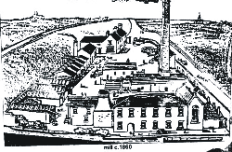
The same process was carried out with the flint. It was John Astbury a Staffordshire potter who first used calcined flint to improve the quality of earthenware. The addition of the flint made the pottery whiter.
The need for these products to feed the ever expanding china industry was one of the reasons that Jesse Shirley established his Bone & Flint Mill in 1857. The mill, the last steam powered mill in the country, ceased production in 1972.
Although the Etruria mill itself is no longer working, nearby the company still produce calcined bone.
The company also produces slip, a mixture of clay and water, for use by Wedgwood's. And there is still a Jesse Shirley (known as Mike) in the business. The mill was scheduled an ancient monument in 1975, the mill is 'in steam' seven times a year when the 1903 boiler is fired up and the historic machinery can be seen working. Well worth a visit if you are in the area and not too far for a special trip. The museum's address is Lower Bedford Street, Stoke-on-Trent Staffordshire ST4 7AF. Tel: 0178233144. It has a long web address so just put in Etruria Industrial Museum.
Meg Thomas, Feb 08
What is ‘Fulling’?
I researched this article after becoming increasingly frustrated by my ignorance in this field. Hopefully a better researched article can be provided for the Museum, but I hope this interests and amuses you in the meantime. For more reading there is an extremely good article on this, with many more illustrations, on the Isle of White History Centre website - Ed
Few people today know what a fulling mill did, but, like all medieval industrial or commercial activities, it has left its mark on us today.
The Merton telephone directory for 2007/8 lists 4 subscribers named ‘Fuller’, 11 named ‘Tucker’ and more than 40 named ‘Walker’. Fulling, tucking and walking were all medieval words for the same process, and those employed in the industry will have adopted those names as was then the practice.
There are 4 steps to fulling - scouring, thickening, rinsing and stretching. Originally carried out manually, watermills were in use for the process from the 12th to the 17th centuries along the Wandle at sites in Wandsworth, Wimbledon, Merton and Hackbridge.
The scouring process needed less mechanisation, being the process by which all chemical impurities in the basic cloth was removed by dousing in the appropriate cleansing liquid - originally human urine, then a mixture using fullers earth.
The thickening process required the cloth to be beaten, with the pounding of hammers driven by water wheels taking over from the pounding of feet (walking) or beating of sticks (tucking).
Water wheels allowed the mechanisation of the rinsing process, too, using the plain water from the river to remove the scouring liquids.
At this stage the material will have shrunk by up to 25% both along the warp and the weft, and become thicker and smoother, and more windproof as the gaps left by the looser weaving process became extinguished.
Finally we reach another of the processes which has left its mark on our
vocabularies - the fabric was stretched on large adjustable frames known as
‘tenters’. Around the frames were a series of large hooks to which the fabric
was attached, hence ‘tenterhooks’.
Being ‘kept on tenterhooks’ has
become synonymous with being kept in
suspense, although the process itself
went out
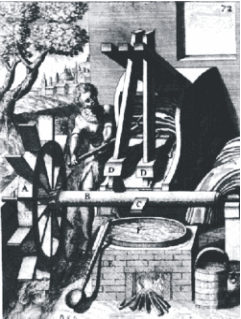 This 17th Century illustration shows a
waterwheel A turning a shaft B on which
extended cams C revolve, picking up the
ends of the suspended hammers (or stocks)
D and letting them drop onto the cloth. The
curved end of the stock lifts the cloth a bit
as it strikes it, allowing the cloth to be
rotated, and the fulling process spread
evenly across it. Illustration courtesy Isle of
White History Centre website
This 17th Century illustration shows a
waterwheel A turning a shaft B on which
extended cams C revolve, picking up the
ends of the suspended hammers (or stocks)
D and letting them drop onto the cloth. The
curved end of the stock lifts the cloth a bit
as it strikes it, allowing the cloth to be
rotated, and the fulling process spread
evenly across it. Illustration courtesy Isle of
White History Centre website
of use 4 centuries ago.
And why was all this necessary? Wool comes in short or long ‘staple’ which refers to the lengths of the individual hairs in the wool which have been spun into thread. In a long staple, which is more commonly called ‘worsted’, the extra length of the hairs allows a natural strength to the thread, so the process can be carried out exerting greater stresses, and allowing a naturally tighter weave.
However a short staple thread, because of the reduced overlap between individual hairs, has little natural strength, and has to be woven much looser to avoid the threads breaking. It is to counter this that the fulling process developed.
Felt is an example of the extreme - very short staple thread is treated even more severely, and the condensing effect of this extended fulling will tend to produce a thicker but very smooth, cloth.
PS - We’ve probably all heard of the town of Tonypandy in Wales - but how many of us know that ‘pandy’ is the Welsh name for a fulling mill? I certainly didn’t. Ed., Feb 2008
The Vestry Hall Annexe, London Road, Mitcham, Surrey CR4 3UD
Tel: 020-8648-0127
~~~~~~~~~~
OPEN: Every Wednesday 1 ~ 4 pm;
First Sunday of each month 2 ~ 5 pm.
~~~~~~~~~~
The Museum is also open to schools and groups by appointment.
~~~~~~~~~~
Admission: Adults 50p, Children & Senior Citizens 20p
The Wandle Industrial Museum would like to point out that the views of contributors to this newsletter are not necessarily the views of the Museum. We would be happy to give the right to reply to anyone who finds the content contentious.



